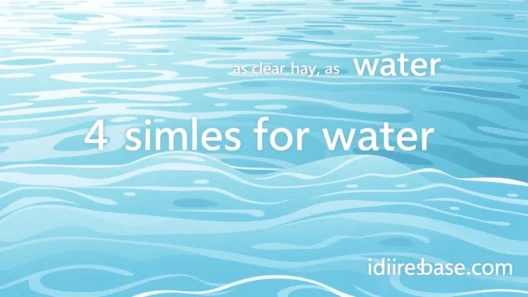Have you ever tried to describe silence? It’s a funny thing, isn't it? It’s not a sound, but the absence of sound. Yet, we often use words to paint a picture of it, to give it form and feeling. From the hushed awe of a snowy morning to the unsettling quiet of an empty house, silence can be so many things. It can be peaceful, profound, unsettling, or even deafening.
But how do you capture that elusive quality in words? That's where similes come in! Similes are like little magic wands that help us compare one thing to another, making our descriptions vivid and memorable. They allow us to understand the unfamiliar by relating it to something we already know. So, if you're looking to add a touch of poetic flair to your writing or simply want to explore the many facets of quiet, you've come to the right place!
Let's dive into 40 wonderful ways to describe silence, helping you unlock new levels of descriptive power.
Similes for Silence: Painting a Picture with Words
Silence can be a powerful thing, and these similes help us truly grasp its essence.
- As quiet as a mouse: A classic, imagining a tiny creature tiptoeing around.
- As silent as the grave: A profound and often eerie comparison, highlighting absolute stillness.
- Like a tomb: Similar to the grave, suggesting a place devoid of life and sound.
- Like falling snow: Soft, gentle, and muffling all other sounds.
- Like a blanket of fog: Obscuring and quieting everything around you.
- As still as a painting: Frozen in time, without movement or sound.
- Like a whispered prayer: Reverent, barely audible, and deeply personal.
- As deep as the ocean floor: Unfathomable, dark, and utterly still.
- Like a vacuum: Emptied of all air and, by extension, all sound.
- As heavy as lead: A silence that feels oppressive and difficult to break.
- Like a held breath: Anticipatory, tense, and temporary.
- As vast as outer space: Limitless, empty, and without echo.
- Like a dream: Surreal, detached, and often without distinct sounds.
- As clean as a whistle: Utterly clear, with no lingering noise.
- Like a locked vault: Secure, impenetrable, and keeping all sounds within or out.
- As pure as virgin snow: Untouched, untainted by noise.
- Like a forgotten room: Dusty, undisturbed, and full of quiet history.
- As thin as ice: Fragile, easily broken, and hinting at potential noise.
- Like a stopped clock: Time stands still, and so does sound.
- As sharp as a knife: A silence that cuts through everything else, almost painful.
- Like a spell: Enchanting, holding everything in its thrall.
- As empty as a drum: Hollow, resonating with nothing.
- Like a shadow: Elusive, following without a sound.
- As deafening as a roar: An ironic simile, highlighting an overwhelming, oppressive silence.
- Like a soundproof booth: Designed to keep all noise out.
- As smooth as glass: Reflecting nothing, not even sound.
- Like an unspoken secret: Held tightly, not meant to be revealed.
- As cold as stone: Unyielding, lifeless, and without warmth or sound.
- Like a paused movie: Everything frozen, no dialogue, no background noise.
- As complete as night: Encompassing, covering everything in its darkness and quiet.
- Like a library at midnight: Reverent, hushed, and full of quiet contemplation.
- As thick as molasses: Slow, heavy, and absorbing all sound.
- Like a forgotten memory: Fading, distant, and without a clear sound.
- As fragile as a butterfly's wing: Easily disturbed, delicate quiet.
- Like an untrodden path: New, undisturbed, and quiet.
- As bright as a star: Standing out, almost glowing in its intensity, even without sound.
- Like a still photograph: Capturing a moment without any audible elements.
- As vast as the desert: Sprawling, empty, and silent except for the wind.
- Like a deep well: Echoing only with its own emptiness.
- As final as a period: Marking an end, a complete stop to all noise.
Key Takeaways
- Similes are powerful tools: They help describe abstract concepts like silence by comparing them to concrete things.
- Silence has many shades: It can be peaceful, scary, profound, or simply absent.
- Context is key: The best simile for silence depends on the specific feeling or atmosphere you want to convey.
- Experiment and play: Don't be afraid to try different comparisons to find the perfect fit for your writing.

Frequently Asked Questions
Q1: Why are similes important for describing silence?
Similes are incredibly important because silence isn't something you can easily see or touch. By comparing it to familiar objects or experiences, similes help readers feel the silence, whether it's the peaceful quiet of falling snow or the eerie stillness of a tomb. They add depth and imagery to your writing.
Q2: Can silence be "loud"?

Absolutely! This is where ironic similes come in handy. For example, "as deafening as a roar" or "a silence that screamed." This isn't literal loudness, but rather a silence so profound or unsettling that it feels overwhelming, almost like a pressure in your ears. It highlights a very intense, often uncomfortable, quiet.
Q3: How can I choose the best simile for my writing?
Think about the emotion or atmosphere you want to evoke. Is the silence peaceful, ominous, reflective, or startling?
- For peace: "Like falling snow," "as quiet as a mouse."
- For dread: "As silent as the grave," "like a tomb."
- For anticipation: "Like a held breath."
- For vastness: "As vast as outer space."
Choosing the right simile brings your description to life and truly resonates with your reader.
Q4: Are there other literary devices similar to similes for describing silence?
Yes! While similes use "like" or "as" to make a comparison, metaphors state that one thing is another (e.g., "Silence was a heavy blanket"). Personification gives human qualities to inanimate objects (e.g., "The silence crept in"). All these devices help to add richness and depth to your descriptions of silence.
Q5: How can using these similes improve my writing?
Using a variety of similes for silence makes your writing more vivid, engaging, and memorable. It shows a command of language and allows you to convey nuanced meanings. Instead of just saying "it was quiet," you can paint a picture that draws the reader in and makes them feel the quietness, whether it's comforting or unsettling. It adds a layer of artistry to your prose.
So, the next time you encounter silence, take a moment to truly feel it, and then, with the help of these similes, you’ll be ready to describe it in a way that truly captures its essence. What's your favorite way to describe silence? Share your thoughts and let's keep the conversation (quietly) going!






